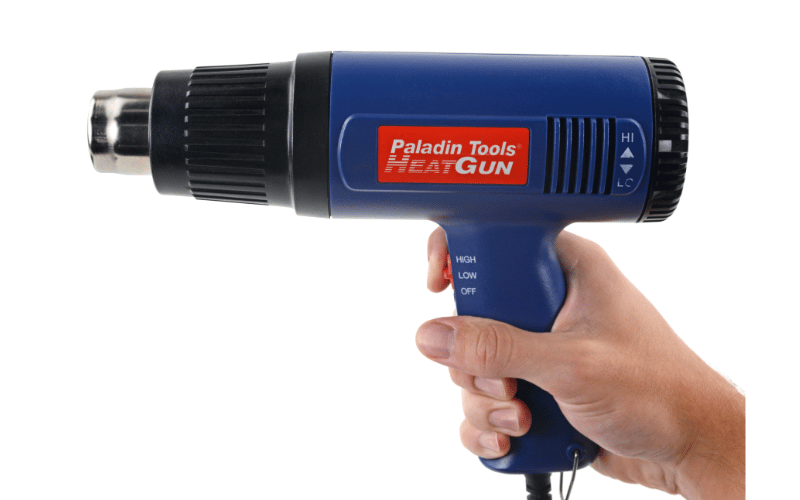Can you use a heat gun for soldering?

Introduction
Heat guns are incredibly versatile tools, offering a wide range of applications in various industries and DIY projects. They can be used for paint removal, plastic welding, shrink wrapping, and even soldering. In this article, we’ll explore the practicality of using a heat gun for soldering, along with the essential safety precautions, benefits, and considerations involved in this process.
Answer to the Question
Yes, a heat gun can be effectively used for soldering various components, circuit boards, and other delicate electronic work. It provides a controlled stream of hot air, which can aid in melting the solder and creating strong electrical connections. However, using a heat gun for soldering requires a thorough understanding of safety precautions and appropriate techniques for reliable results.
Safety Precautions for Using a Heat Gun for Soldering
Understanding Heat Guns
Before using a heat gun for soldering, it’s essential to understand the basic principles of how heat guns operate. These versatile tools are designed to generate hot air by passing it over a heating element, allowing for precise temperature control. Heat guns can reach high temperatures suitable for soldering, making them an indispensable tool in electronics work. Let’s explore in more detail the key components, applications, and safety considerations when using heat guns for soldering:
- Components: Heat guns typically consist of a heating element, a fan to produce airflow, temperature controls, and a nozzle for directing hot air.
- Applications: In addition to soldering, heat guns have a wide range of applications such as paint stripping, plastic welding, shrink wrapping, and thawing frozen pipes.
- Safety Considerations: When using a heat gun for soldering, it’s crucial to protect yourself and the surrounding components from the high temperatures. This involves wearing heat-resistant gloves, working in a well-ventilated area, and using heat shields to direct the airflow away from sensitive components.
Types of Heat Guns
There are several different types of heat guns, each with its own unique features and applications. Understanding the distinctions between these types is crucial for selecting the right heat gun for soldering requirements. The following are the main types of heat guns:
- Industrial Heat Guns: These heat guns are designed for heavy-duty applications in industrial settings. They are known for their high heat output, durability, and ability to withstand continuous use. Industrial heat guns are commonly used in manufacturing, automotive, and construction industries.
- DIY Heat Guns: Also known as hobbyist heat guns, these are designed for everyday household and hobbyist projects. They are more compact and versatile, making them suitable for a wide range of applications such as crafting, electronics repair, and DIY home improvement projects.
Industrial and DIY heat guns differ not only in their intended applications but also in their power, temperature control features, and ergonomic designs. When choosing a heat gun, it’s important to consider the specific requirements of the soldering task at hand and select the most appropriate type of heat gun accordingly.
Choosing the Right Temperature
When using a heat gun for soldering, it’s crucial to set the temperature to an appropriate level. Different soldering tasks may require varying temperatures, and selecting the right setting is imperative to achieve precise and reliable results. Additionally, understanding the heat gun’s temperature settings and adjustments is essential for safe and effective soldering.
- Material: The type of material being soldered influences the temperature setting. For instance, delicate electronic components require lower temperatures, while heavier gauge wires may need higher temperatures to ensure proper solder flow.
- Solder Type: Different solders have distinct melting points, so it’s important to match the heat gun’s temperature to the solder being used. Lead-based solder, for instance, melts at a lower temperature compared to lead-free solder.
- Task Complexity: Intricate soldering tasks, such as surface mounting, demand precise temperature control to avoid damaging the components. More straightforward jobs may allow for a wider temperature range.
Most modern heat guns feature adjustable temperature settings, typically ranging from around 120°C to 600°C or more. The temperature control can be in the form of a dial, digital display, or preset heat settings. Having a clear understanding of the temperature settings is essential for achieving optimal results.
Appropriate temperature control is vital for successful soldering, as it enables the solder to flow effectively and form strong, durable joints. Without proper temperature regulation, the solder may not adhere properly, leading to weak connections and potential electrical issues.
Using the Heat Gun for Soldering
When using a heat gun for soldering, it’s important to maintain a steady hand and apply the heat evenly to prevent overheating or damaging the components. The right technique, combined with the appropriate temperature and safety measures, ensures successful soldering without compromising the integrity of the materials being worked on.
When it comes to using a heat gun for soldering, there are advanced techniques that can elevate the quality of your work:
- Heat Control: Adjust the temperature settings on the heat gun to the specific melting point of the solder being used, ensuring precise control over the process.
- Heat Distribution: Master the art of evenly distributing heat across the soldering area to achieve consistent and reliable results.
- Angular Approach: Experiment with different angles and distances to understand the impact on heat distribution and soldering quality.
These advanced techniques not only improve the efficiency of the soldering process but also contribute to the durability and performance of the soldered components.
Benefits of Using a Heat Gun for Soldering
Versatility
A heat gun provides exceptional versatility in soldering tasks, offering precise temperature control and focused heat application to accommodate various soldering needs. This adaptability makes it suitable for intricate electronic work as well as larger soldering projects, providing an all-encompassing solution for diverse applications.
- Variable Temperature Control: The heat gun’s precise temperature control allows for flexible use across a wide range of soldering tasks, from delicate electronic components to larger projects.
- Focused Heat Application: Its ability to provide focused heat application ensures efficient and targeted soldering, reducing the risk of damage to surrounding materials.
- Compatibility with Various Materials: From circuit boards to larger metal components, the heat gun’s versatility allows for effective soldering on a wide range of materials, enhancing its utility in diverse applications.
- Adaptability for Complex Projects: Its versatility extends to intricate electronic work, where precision and control are paramount, making it an essential tool for soldering intricate components.
Efficiency
Using a heat gun for soldering is highly efficient, as it expedites the soldering process by quickly melting the solder for seamless joint formation. The controlled and concentrated heat application ensures efficient transfer of heat to the targeted area, resulting in precise and effective soldering outcomes.
- Consistent and Reliable Performance: A heat gun provides consistent and reliable performance, ensuring that the soldering process is completed with accuracy and uniformity.
- Time-Saving: The rapid heating capability of a heat gun saves time by quickly melting the solder, reducing the overall soldering time and enhancing productivity.
- Optimal Heat Distribution: The controlled application of heat ensures that the targeted area receives the optimal amount of heat, leading to efficient soldering without the risk of overheating or damage.
Cost-Effectiveness
A heat gun is an incredibly cost-effective tool for soldering tasks. It provides numerous advantages that contribute to its cost-effectiveness:
- Elimination of Specialized Soldering Irons: Heat guns eliminate the need for specialized soldering irons and related accessories, which can be expensive and require additional maintenance.
- Multi-Functional Capabilities: With their versatile nature, heat guns offer a cost-efficient alternative for various soldering applications. They can be used for heat shrink tubing, paint removal, plastic welding, and more, making them a valuable addition to any soldering toolkit.
- Long-Term Savings: Investing in a high-quality heat gun can lead to long-term savings by eliminating the need for multiple other tools. This decreases the overall cost of equipment and maintenance, providing an economical solution for soldering tasks.
Conclusion
Using a heat gun for soldering proves to be a viable and efficient method, encompassing a wide range of applications from delicate electronic work to larger soldering projects. With the right temperature control and adherence to safety measures, heat guns offer an effective and versatile solution for soldering tasks. Their efficiency, adaptability, and cost-effectiveness make them a valuable tool for DIY enthusiasts and professionals alike.
